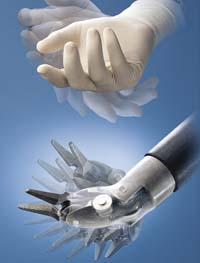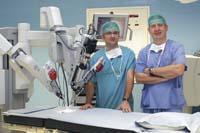Robot surgeon Da Vinci

Do not breathe or breathe. There is no problem with the bad pulse of surgeons. Da Vinci has neither bad nor good pulses, nor therefore the smallest tremors. It is capable of making clean, very precise cuts, it sees it in three dimensions and can reach places where the hands of surgeons of meat and bone cannot reach.
In Euskal Herria we already have two Da Vinci. The first arrived at the Virgen Blanca Clinic in Bilbao at the end of 2006, and since last November has joined Policlínica Gipuzkoa in San Sebastián. It is a robot designed for small wound surgery that is giving excellent results all over the world.
Da Vinci will not leave the surgeons of Bilbao and San Sebastián without work. True surgeons are still essential. The Da Vinci robot has no heart, but no brain, at least autonomous, and can do nothing alone: someone has to give him orders. Therefore, if Da Vinci is going to do a good job, he must be in the hands of a good surgeon.
The surgeon who works with Da Vinci does not work on the patient as in the usual operations. On the other hand, he sits in the consola located a few meters from the operating table, from where he controls the four arms of the robot that enter the body of the patient. The work done by the robot is similar to a laparoscopy, but it has many more advantages.
Small wound surgery
Laparoscopy was a major breakthrough in its day. The operations consist of replacing the opening of the body with small incisions that introduce a camera, light and tools. This reduces postoperative time and risks of infection and discomfort. In fact, large scars, percentage pain and continuous bleeding are avoided.

And Da Vinci goes one step further. It has the same advantages as laparoscopy, but also more.
One of the advantages of Da Vinci regarding laparoscopy is its ability to see in three dimensions. In one of the arms there are two cameras and the consola has a viewfinder for each eye. Thanks to this it is possible to see it in three dimensions. In addition, it allows to expand the image up to 12 times. In this way, the surgeon gets a feeling that is really inside the body of the patient.
On the other hand, surgeons who have used the robot highlight their enormous maneuvering capacity. In fact, at the end of each arm, Da Vinci has a mechanism called endowristán (inner wrist). It imitates the movement of the human wrist, but has a much greater angle of movement, which allows it to perform operations that cannot be performed with human hands. On each robot doll you can place any tool: to grab, cut, sew, coagulate, authenticate, etc.
Another advantage that surgeons mention is that the robot allows to completely eliminate the tremor of surgeons, both for fatigue in prolonged operations and for physiological pulse. Da Vinci handles a surgeon who works very comfortably seated and with the head inserted into the contour without seeing anything else. This significantly improves fatigue and concentration problems.
In addition, the mastery of the technique is much simpler than in the case of laparoscopy. Although it varies depending on the type of intervention, a laparoscopy is done 50 or 100 times to learn how to do it well, while with Da Vinci you can get a great skill in 10 or 25 sessions.
Specialist in Urology

Da Vinci is applicable in specialties such as general surgery, gynecology, cardiac surgery or pediatrics. But his greatest experience is in urology. In particular, he works in the Urology Service, both in Bilbao and Donostia. More specifically, it is used for the surgical treatment of prostate cancer in the White Virgin and Polyclinic Gipuzkoa.
Prostate cancer is treated by radical prostatectomy (complete removal of the prostate). This operation may have important side effects such as the inability to maintain urine or sexual impotence. And with Da Vinci, these side effects are significantly reduced.
They have more experience than here in the US. They have been there for about eight years working with Da Vinci and many radical prostatectomies are made with the robot. The work carried out over these years has shown that 98% of patients treated with the robot manage to keep the urine completely, while 60% maintain sexual power. On the other hand, the mean remaining residual tumor (9%) is much lower than in the case of laparoscopy (20%), with 94% of patients completely 'clean'.





